You may have run across a symbol that looks like a squiggly, or zigzag line in your music and you just aren’t sure what it means. Well, there are several squiggly/zigzag lines that can be found in music. So it depends on what you have found!
A squiggly or zigzag line in piano music can be a mordent (or shake), a trill, a glissando, or an arpeggiated chord. A squiggly or zigzag line in guitar music can mean to draw out a strum on the guitar.
- Mordent (sometimes called a “shake”): a horizontal squiggly/zigzag line above the note
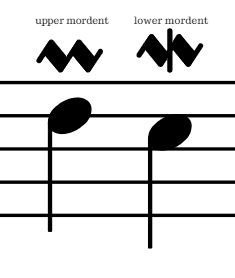
- A trill: a hortizontal squiggly/zigzag line usually after a “tr” above the note
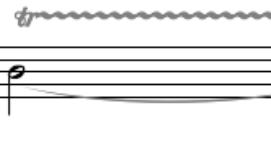
- Glissando: a squiggly/zigzag line that is diagonal between two notes

- Arpeggiated chord: a vertical squiggly/zigzag line before a chord

- To strum the guitar: a vertical squiggly/zigzag line before a chord

It certainly is helpful to know what you are looking at and how to play the music as written! So let’s take a closer look.
Mordent (sometimes called a “shake”)
If the squiggly line you are looking at is above the note, then we call that a mordent. It is a small squiggly line that is horizontal and placed directly over the note. A mordent is a musical symbol that tells the player to use two notes and play them rapidly together. You will want to do this quickly and precisely, which may take a bit of practice, because the trick is to be able to play the mordent while still maintaining the rhythm of the note and not losing the timing in the measure.
You will often find mordents in classical or baroque music. It takes a bit of precision and technique to play a mordent. Someone like Bach who likes to use technique and precision in music will often use mordents throughout the song. You may recall listening to classical music with a harpsichord. You may recall hearing that classic mordent (or fast trill of notes) throughout the song. I totally think of classical music when it comes to mordents, although it isn’t just classical music that makes use of a mordent.
If you are going to get really technical, there are different types of mordents. You have an upper mordent and a lower mordent.

The lower mordent plays the note written in the music, the next note down, and then back to the original note — all very quickly and within the rhythm of the original note. Although you do have the license to play the mordent within the rhythm and timing of the piece and your own style of playing.
An upper mordent is a symbol used to play the note above, and then the note written, followed by the note above.
Perhaps you can see why a mordent is called a shake. You “shake” between two notes.
Trill

A trill is a horizontal squiggly or zigzag line above the note. Usually, a “tr” is written before the squiggly line. A trill is similar to a mordent. Except that you have a little more liberty in playing more of the trill notes, usually with a minimum of four notes. You alternate between either the note above or the note below in playing the notes quickly together. Playing the note above the trill is more often heard in classical or baroque styles of music. But of course it is up to the discretion of the pianist to determine which way he/she prefers to play it.
Often times a trill is accompanied by a slowing down of the song so that it can be drawn out a little.
The note that is played above or below the note written in a trill, is the next note in the scale. For instance: if you are in C Major scale and a C has a trill written over it, the C and D would be played in the trill, since a C major scale is C-D-E-F-G-A-B. You would not play a C#.
A trill is also symbolized with just a “tr”.
Sometimes, you can find a trill finished with what can be called “a turn”. The trill begins with the note above the note written, then finishes with the last eighth notes as written.
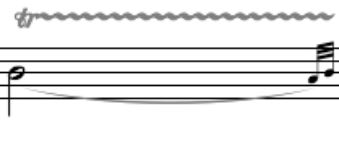
Glissando

A glissando is a diagonal squiggly/zigzag line written between two notes. A glissando is such a fun symbol to find, in my opinion. It means to play each white note between the two notes written. Begin on the note written, glissando (or quickly play up or down the keyboard with your thumb or fingers) and end at the note written.
A glissando can be played whichever way a pianist prefers. But I like to turn my wrist and use the side part of my thumbnail to drag up and down the keys. It can be done quickly and is a little less painful then using some of my other fingers. Or I use the fingernails of my four fingers on my hand to drag up the piano. Or the pads of my fingers to drag down the piano.
Try out what works best for you! You just need to watch out to make sure you are hitting as many keys as possible, being able to drag up and down in a legato fashion, and do it quickly — you don’t usually have much time!
You will find that it may hurt a little when you first start doing glissandos. Don’t worry – this is normal. But you will find that it doesn’t hurt after you practice it over the space of a few days. Your hands can build up a bit of a callous to it.
An Arpeggiated Chord

If you find a squiggly line vertical next to a chord, you could be looking at an arpeggiated chord. You may have heard of arpeggios. An arpeggio is a series of notes played one after another, usually played from a chord. An arpeggiated chord shows that a pianist should play the chord in a drawn out fashion. That is to say, start with the bottom note of the chord, and quickly play each note one on top of the other until you have built the chord completely. You need to do this in the timing as written, so it should be done quickly. To the ear, it sounds like the chord was played just slightly separate. You do want to hold each note as you play it so that all notes are being played simultaneously even if only for a second by the time you finish the chord.
If the squiggly line has an arrow pointing down, then the chord should be played going from the top to the bottom. Usually their is not an arrow, so you play it going up by default
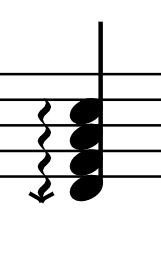
To Strum on the Guitar

You may find a similar zigzag or squiggly vertical line next to a chord in your guitar music. This line is intended to have you strum the guitar, but do so with a little more timing. Each string is played a little slower then just a typical strum, so that it is drawn out. It does still need to be played fast enough to still be considered a strummed chord.
This symbol is usually found when you slow the music down. It often shows emphasis to a chord either to finish it, or to draw out a part of the song.
Learn to Play Piano
Combining all that I have learned in teaching piano on and off for the past 17 years, I have created my very own, all virtual Learn with Pianotels program that is proving to be phenomenal for students. With a self-paced step-by-step course, the latest technology, and video chats available at any time, students are not only having a blast learning piano, they are also learning piano 8-10x faster than traditional lessons. I can’t be more excited about this program and the results I am seeing!
Just because it is tailored for kids, don’t let that hold you back from trying it out yourself. Adults have benefited just as much from kids in this course! So even though it is advertised for kids, give it a go. Learn with Pianotels is affordable for the whole family!
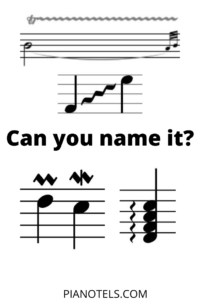
Tel loves her life as a piano player, a piano teacher, and a mom. Amid piano blogging, piano teaching, and piano playing, she loves a chance to fit in a good exercise class, volunteer at her kids’ school and at her church, and go on long dates with her husband. Full bio at About Tel.



Thanks Tel,
I played classical violin for ten years as a child 6-16 yrs old. I stopped when my teacher wanted me to continue working on grade 5 and I wanted to start learning jigs and folk music. After a 20 year hiatus, the “Fiddle” is now out and I am playing folk music like I should have when I was 16. However, working out what a Mordent was after all these years was too much to remember. Yours was the first site and clear enough to understand a precis at the beginning and deeper understanding below. Brilliantly written page of info. I am sure you are a wonderful teacher. Thank you for the theoretical revision. Once the Covid thing comes to an end I will be back at the folk festivals and playing in Celtic sessions again. I hope you are safe and family and friends are happy and healthy.
Kind regards,
Todd
I really appreciate your kind words and encouragement of my efforts to make music a little easier to understand. I am so happy you have pulled out the fiddle and can enjoy it now as you continue to learn. I wish you all the best as you spread your love and joy of music!
Great explanation, thank you so much
Thank you so much for putting squiggling all together. It is hard to find on the web clear and consigne explanation.
You wrote:
“An upper mordent is a symbol used to play the note above, and then the note written, followed by the note above.”
This is not correct. An upper mordent is a symbol used to play the note written, and then the note above, followed by the note written.
(A mordent should always end with the written note.)
I have seen it both ways! Thanks for pointing that out.